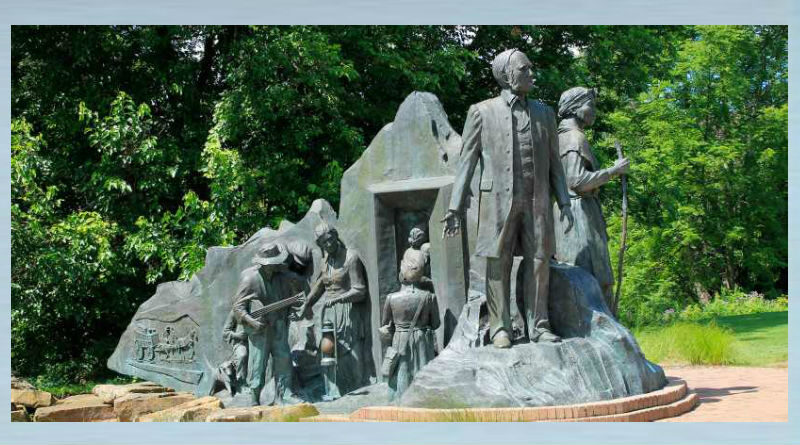Underground Railroad Sculpture
Updated on 23 February 2021
At 28-feet-long and 14-feet high, the bronze Underground Railroad Sculpture is America’s largest monument to ending slavery.
The figures helping the slaves to freedom are abolitionist Harriet Tubman, known as ‘Black Moses,’ and local Quaker ‘Conductors’ Erastus and Sarah Hussey. Designed by sculptor Ed Dwight the sculpture is located near the Kellogg House in downtown Battle Creek, Michigan.
The sculpture was comissioned by the W.K. Kellogg Foundation to honour the courageous men and women who operated the Underground Railroad, as well as the fugitive slaves they helped to flee the American South to a new life in the North.
How The Railroad Operated
The Underground Railroad is a term used from about the 1840s to describe an informal network of secret routes and safe houses used by the fugitive slaves on their journey north to either the ‘Free States’ or Canada. The railroad spanned 29 states, as well as Canada, Mexico and the Caribbean. Quakers played an active part in it, along with many others.
It was called ‘Underground’ because it was secret and ‘Railroad’ because it marked the ‘passenger’ journey of the fleeing slaves. The safe houses that were used were known as ‘stations’ and those who allowed their property to be used in this way were known as ‘station masters’.
Those who contributed money or goods to help were called ‘Stockholders’. The fugitives were described as ‘goods’ to help them to be less easily identified. ‘Conductors’ were those who planned the routes and often helped and accompanied the slaves in their bid for freedom.
The fugitives moved during the hours of darkness from one station to the next. Stations were usually between 10 and 20 miles apart and the fugitives either walked between them or were hidden in either covered wagons or wagons with false bottoms.
The North Star was used as a guide to find the way.
Beginnings And Endings
Although the Underground Railroad began in the 1840s, its roots date back much further. One of the earliest references to runaway slaves receiving organized assistance comes from a 1786 letter written by George Washington. A slave escaped from one of his neighbours and Washington opined that:
“A society of Quakers, formed for such purposes, have attempted to liberate him…acting repugnant to justice…[and] in my opinion extremely impolitely with respect to the State.”
George Washington
By 1850, more than 3,000 people were working with the Underground Railroad. They risked both fines and imprisonment for trying to help the runaway slaves or ‘Fugitives from Work’ as they were also called.
African Americans like Harriet Tubman, a former slave who made 19 journeys to help first her own family and then other slaves, probably made the greatest contribution, but many others were involved. These were drawn from Methodists and other evangelical groups, as well as Quakers.
By the middle of the 19th century, it is estimated that over 50,000 slaves had escaped from the South using the Underground Railroad. Plantation owners became concerned about the number of slaves who were managing to escape and in 1850 they persuaded Congress to pass the Fugitive Slave Act. Federal marshals who did not arrest an alleged runaway slave could be fined $1,000.
People who aided the escapees by providing shelter, food or any other form of assistance could be imprisoned for six months and receive a fine of $1,000. The Fugitive Slave Act did not stop the Underground Railroad from operating.
Quaker Involvement
There are records of 82 Quakers being involved in Chester County in Pennsylvania alone. Other Underground Railroad Quaker strongholds were Salem, Iowa; Newport, Indiana; Alum Creek, Ohio; Cass County, Michigan; Farmington, New York; and New Bedford, Massachusetts.
Quaker Thomas Garrett (1789 – 1871) is reputed to have helped over 2,700 slaves to escape and was known as the ‘Station Master’ of the final Underground Railroad station, which was in Wilmington, Delaware. He worked on the Underground Railroad for about 40 years and although he was fined more than $5,400 for helping runaway slaves it did not deter him.
Quaker Levi Coffin (1798 – 1877), based in Cincinnati, Ohio, was known as the ‘President’ of the Underground Railroad. He and his wife Catherine, also a Quaker, helped about 2,000 slaves to freedom,
Some Quakers did not feel that acting outside the law was appropriate, despite their concern for the slaves’ plight. They thought that it was better to work within the existing law for the complete abolition of slavery, as this would benefit all slaves rather than the few runaways that they could conceivably help as individuals.
The Underground Railroad came to a natural end with the abolition of slavery at the end of the American Civil War (1861-65) and is Panel 64 (opens in a new tab) on the Quaker Tapestry.
Images from battlecreekvisitors.org/

